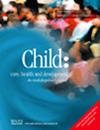Comparing Hip, Wrist and Ankle-Worn ActiGraph Accelerometers for Measuring Physical Activity in Toddlers
Abstract
Background
Understanding the relationships among accelerometer placements and the agreements between cut points is essential to enhancing the accuracy of physical activity measurement for toddlers. This study aimed to compare the magnitudes and relationships of activity counts from hip, wrist and ankle ActiGraph GT9X accelerometers in toddlers and to assess the agreement between age-specific cut points at group and individual levels.
Methods
Accelerometer data were collected from nine toddlers (three girls, 22.2 ± 6.1 months) during 12 weekly 20-min free-play sessions. Activity counts were downloaded using specific epoch lengths and filters according to the studies validating the cut points. One-way repeated ANOVAs were used to compare the activity counts per 15 s across placements. Interplacement relationships were examined using Spearman's rank correlation coefficients. Agreements were assessed with Bland–Altman plots between three sets of hip cut points and one wrist cut point. Ankle data were not analysed because of a lack of validated cut points.
Results
The wrist placement yielded the highest counts, followed by ankle and hip. The correlation coefficient was strongest between hip and ankle vector magnitude counts (rs = 0.88), whereas relatively weaker between wrist and hip (rs = 0.65) and wrist and ankle (rs = 0.60). The Bland–Altman plots indicated that time estimates for sedentary, light and moderate-to-vigorous physical activity were significantly different between most cut points. At the individual level, considerable variations in interplacement correlations and physical activity time estimates were observed.
Conclusion
The strong correlation between hip and ankle activity counts suggests that the ankle could be a feasible sensor-wearing location. The moderate correlation between wrist and hip suggests that multiple accelerometers may be needed to enhance accuracy. Discrepancies across cut points indicate that more research is needed to validate cut points for accurately measuring physical activity in toddlers, especially considering individual differences in movement behaviours.

 求助内容:
求助内容: 应助结果提醒方式:
应助结果提醒方式:


